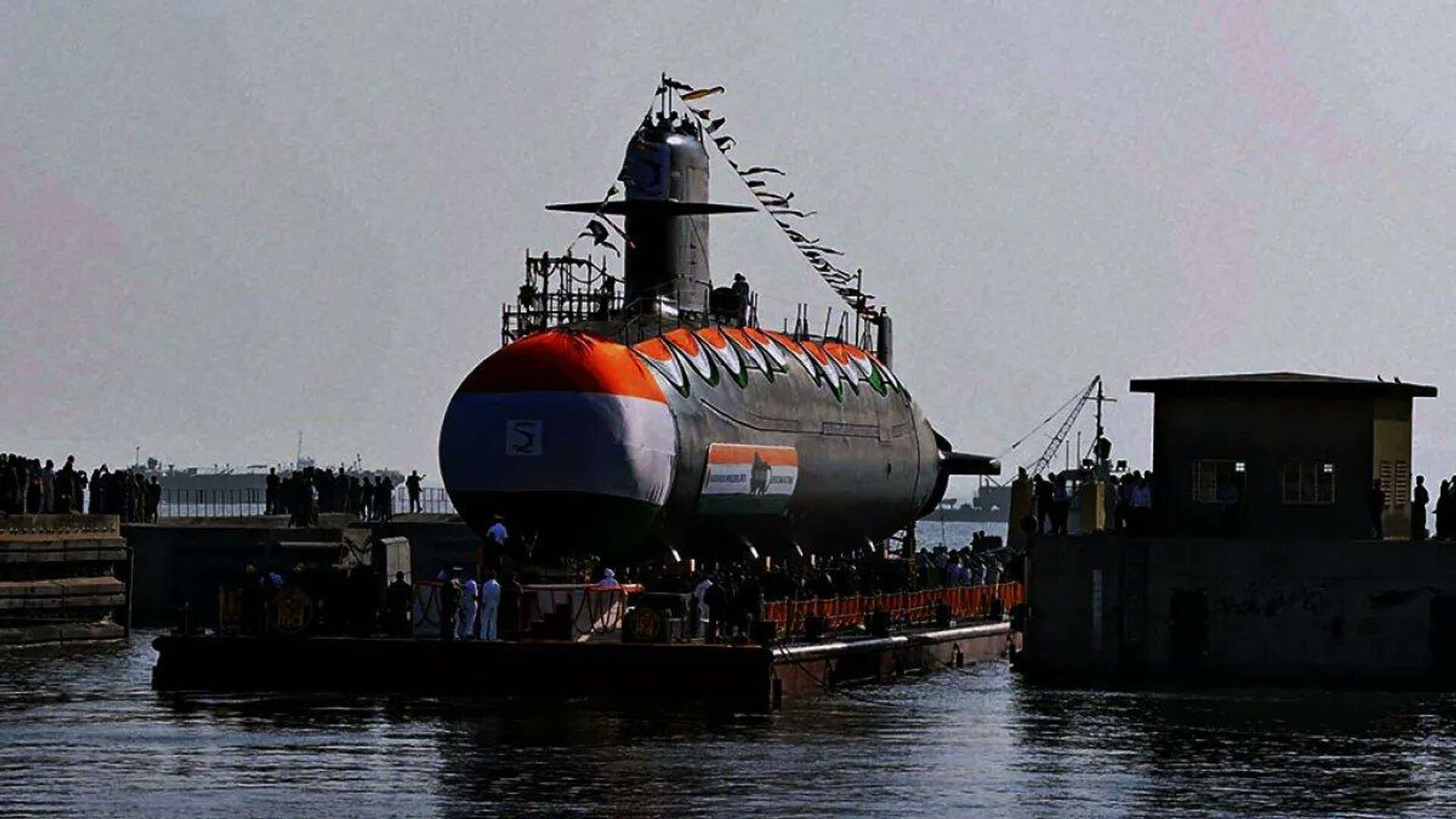https://sputniknews.in/20240904/whats-behind-indias-rising-defence-spending-8108505.html
What's Behind India's Rising Defence Spending?
What's Behind India's Rising Defence Spending?
Sputnik India
The government’s plan to source 99% of defense acquisitions domestically supports Make in India, enhances decision-making, and improves defense capabilities by... 04.09.2024, Sputnik India
2024-09-04T19:41+0530
2024-09-04T19:41+0530
2024-09-04T19:41+0530
defenсe news
india
delhi
pakistan
government of india
ministry of external affairs (mea)
ministry of defence (mod)
defense sector
defense pact
indian air force (iaf)
https://cdn1.img.sputniknews.in/img/07e8/08/1d/8081364_0:63:1200:738_1920x0_80_0_0_0ad11da903ff85263e865be291456d44.jpg
The Indian Defence Acquisition Council has approved a $17.3 billion defence equipment purchase, including locally made future-ready combat vehicles FRCVs, radars, aircraft, and patrol vessels, to strengthen national defence.“For modernisation of the tank fleet, the proposal for procurement of FRCVs has been cleared. It will be a futuristic main battle tank with superior mobility, all terrain ability, multi-layered protection, precision, lethal firepower and real-time situational awareness,” a statement by defence ministry reads.The Indian Army aims to integrate 1,770 FRCVs, advanced battle tanks, to upgrade its armored corps at an estimated cost of $7.2 million.The FRCV and other modernization initiatives are part of ongoing efforts to replace outdated equipment with newer, more capable systems, the Brigadier said.A significant portion of new equipment falls under India’s negative or positive list, emphasizing indigenous development with potential foreign collaboration based on requirements, he added.The ongoing border stand-off and growing Pakistan-China ties heighten India's strategic concerns, Sahgal added, noting that “while neighbors like Bangladesh pose no "immediate threat," contingency planning for redeployments is still crucial.”Amid regional instability, boosting defence is crucial for readiness, he noted, further adding that national security drives these decisions, with strategies influenced by regional factors but guided by national priorities.The government has announced that 99% of defence acquisitions will be sourced domestically, providing a significant boost to the Make in India initiative, Khanna mentioned.With the rupee’s true purchasing power being higher than its exchange rate suggests, spending domestically allows for greater value and improves overall defence capabilities, he affirmed.In the meantime, the aging T-72 and T-90 tanks require replacement with advanced Future Ready Combat Vehicles (FRCVs) to address evolving threats and modernize the armoured fleet, Khanna underscored.The Admiral mentioned that the Indian Navy's wide range of tasks requires diverse ship capabilities, with offshore patrol vessels handling maritime security to let destroyers and frigates focus on combat readiness.Consequently, the variety of expected tasks requires a range of different ships, he noted.Similarly, the Brigadier stated that India is expanding its maritime capabilities by launching a second Arihant-class nuclear-powered ballistic missile submarine (SSBN), pursuing nuclear-powered attack submarines (SSNs), and improving cruise missile and ISR capabilities.These developments are incrementally advanced through the Defence Acquisition Council, which approves projects based on necessity before they enter the implementation phase, Sahgal concluded.
https://sputniknews.in/20240830/rasht-astara-railway-crucial-to-enhancing-indias-trade-volume-8086858.html
india
delhi
pakistan
indian ocean
china
south china sea
china-pakistan economic corridor (cpec)
Sputnik India
feedback.hindi@sputniknews.com
+74956456601
MIA „Rossiya Segodnya“
2024
Swapna Nair
https://cdn1.img.sputniknews.in/img/07e7/09/12/4320104_0:0:681:681_100x100_80_0_0_ca8a7d4d582609272840ffdd1cde7278.jpg
Swapna Nair
https://cdn1.img.sputniknews.in/img/07e7/09/12/4320104_0:0:681:681_100x100_80_0_0_ca8a7d4d582609272840ffdd1cde7278.jpg
News
en_IN
Sputnik India
feedback.hindi@sputniknews.com
+74956456601
MIA „Rossiya Segodnya“
Sputnik India
feedback.hindi@sputniknews.com
+74956456601
MIA „Rossiya Segodnya“
Swapna Nair
https://cdn1.img.sputniknews.in/img/07e7/09/12/4320104_0:0:681:681_100x100_80_0_0_ca8a7d4d582609272840ffdd1cde7278.jpg
indian defence acquisition council, defence equipment purchase, future-ready combat vehicles frcvs, radars, aircraft, and patrol vessels, national defence, modernisation of the tank fleet, procurement of frcvs, superior mobility, all-terrain ability, multi-layered protection, precision, lethal firepower and real-time situational awareness, defence ministry, indian army, advanced battle tanks, future infantry combat vehicle (frcv), t-72 tanks, defence acquisition council (dac), deployment, brigadier (retd) arun sahgal, senior fellow for strategic and regional security at delhi policy group, modernization initiatives, equipment, capable systems, new equipment falls, india’s negative or positive list, indigenous development, foreign collaboration, pakistan-china ties, india's strategic concerns, bangladesh, rear admiral (retd) monty khanna, former assistant military adviser at the national security council secretariat, make in india initiative, defence funds domestically, t-72 and t-90 tanks, ukraine, offshore patrol vessels different ships, lower-end tasks, maritime security, arihant-class nuclear-powered ballistic missile submarine (ssbn), nuclear-powered attack submarines (ssns), cruise missile and isr capabilities, defence acquisition council
indian defence acquisition council, defence equipment purchase, future-ready combat vehicles frcvs, radars, aircraft, and patrol vessels, national defence, modernisation of the tank fleet, procurement of frcvs, superior mobility, all-terrain ability, multi-layered protection, precision, lethal firepower and real-time situational awareness, defence ministry, indian army, advanced battle tanks, future infantry combat vehicle (frcv), t-72 tanks, defence acquisition council (dac), deployment, brigadier (retd) arun sahgal, senior fellow for strategic and regional security at delhi policy group, modernization initiatives, equipment, capable systems, new equipment falls, india’s negative or positive list, indigenous development, foreign collaboration, pakistan-china ties, india's strategic concerns, bangladesh, rear admiral (retd) monty khanna, former assistant military adviser at the national security council secretariat, make in india initiative, defence funds domestically, t-72 and t-90 tanks, ukraine, offshore patrol vessels different ships, lower-end tasks, maritime security, arihant-class nuclear-powered ballistic missile submarine (ssbn), nuclear-powered attack submarines (ssns), cruise missile and isr capabilities, defence acquisition council
What's Behind India's Rising Defence Spending?
The government’s plan to source 99% of defense acquisitions domestically supports Make in India, enhances decision-making, and improves defense capabilities by leveraging the rupee’s true purchasing power, experts have told Sputnik India.
The Indian Defence Acquisition Council has approved a $17.3 billion defence equipment purchase, including locally made future-ready combat vehicles FRCVs, radars, aircraft, and patrol vessels, to strengthen national defence.
“For modernisation of the tank fleet, the proposal for procurement of FRCVs has been cleared. It will be a futuristic main battle tank with superior mobility, all terrain ability, multi-layered protection, precision, lethal firepower and real-time situational awareness,” a statement by defence ministry reads.
The Indian Army aims to integrate 1,770 FRCVs, advanced battle tanks, to upgrade its armored corps at an estimated cost of $7.2 million.
“The FRCV, set to replace T-72 tanks, is in its early stages with initial approval from the Defence Acquisition Council (DAC), and typically takes 7 to 10 years to progress from approval to deployment”, Brigadier (Retd) Arun Sahgal, Senior Fellow for Strategic and Regional Security at Delhi Policy Group told Sputnik India.
The FRCV and other modernization initiatives are part of ongoing efforts to replace
outdated equipment with newer, more capable systems, the Brigadier said.
A significant portion of new equipment falls under India’s negative or positive list, emphasizing indigenous development with potential foreign collaboration based on requirements, he added.
The ongoing border stand-off and growing Pakistan-China ties heighten India's strategic concerns, Sahgal added, noting that “while neighbors like Bangladesh pose no "immediate threat," contingency planning for redeployments is still crucial.”
Meanwhile, the increase in the defence budget aligns with the 7% annual economic growth, resulting in a stable percentage of GDP allocated to military, Rear Admiral (Retd) Monty Khanna, Former Assistant Military Adviser at the National Security Council Secretariat told Sputnik India.
Amid regional instability, boosting defence is crucial for readiness, he noted, further adding that national security drives these decisions, with strategies influenced by regional factors but guided by national priorities.
The government has announced that 99% of defence acquisitions will be sourced domestically, providing a significant
boost to the Make in India initiative, Khanna mentioned.
“Investing in local production not only reduces strategic dependencies and enhances decision-making flexibility but also boosts the economy and supports related sectors by spending defence funds domestically,” the admiral highlighted.
With the rupee’s true purchasing power being higher than its exchange rate suggests, spending domestically allows for greater value and improves overall defence capabilities, he affirmed.
In the meantime, the aging T-72 and T-90 tanks require replacement with advanced Future Ready Combat Vehicles (FRCVs) to address evolving threats and modernize the armoured fleet, Khanna underscored.
"Recent events, such as those in Ukraine, “highlight the urgent need for modernized tanks, and it's reassuring to see this crucial upgrade finally moving forward,” he argued.
The Admiral mentioned that the Indian Navy's wide range of tasks requires diverse ship capabilities, with offshore patrol vessels handling maritime security to let destroyers and frigates focus on combat readiness.
Consequently, the variety of expected tasks requires a range of different ships, he noted.
Khanna pointed out that although high-end ships can handle lower-end tasks, it's inefficient; offshore patrol vessels are specifically designed for maritime security, allowing larger destroyers and heavily armed frigates to focus on their main role of combat readiness.
Similarly, the Brigadier stated that India is expanding its maritime capabilities by launching a second
Arihant-class nuclear-powered ballistic missile submarine (SSBN), pursuing nuclear-powered attack submarines (SSNs), and improving cruise missile and ISR capabilities.
These developments are incrementally advanced through the Defence Acquisition Council, which approves projects based on necessity before they enter the implementation phase, Sahgal concluded.



